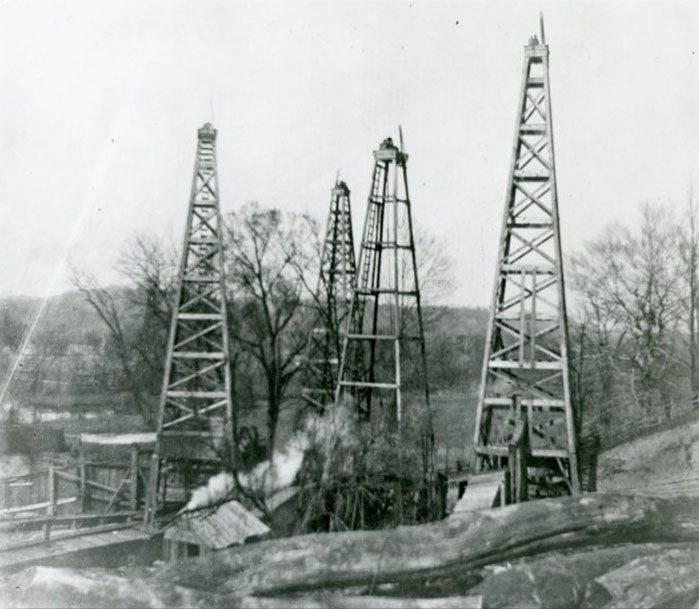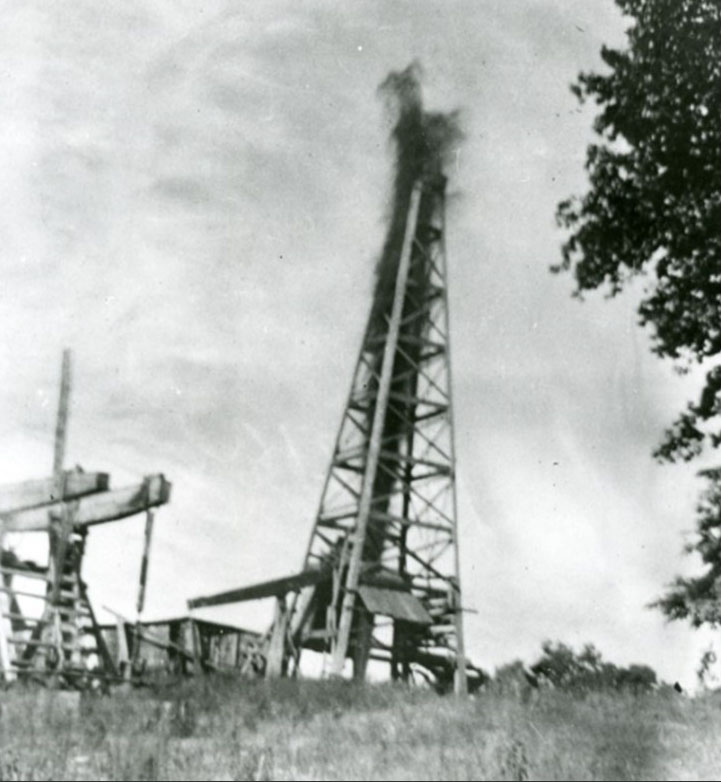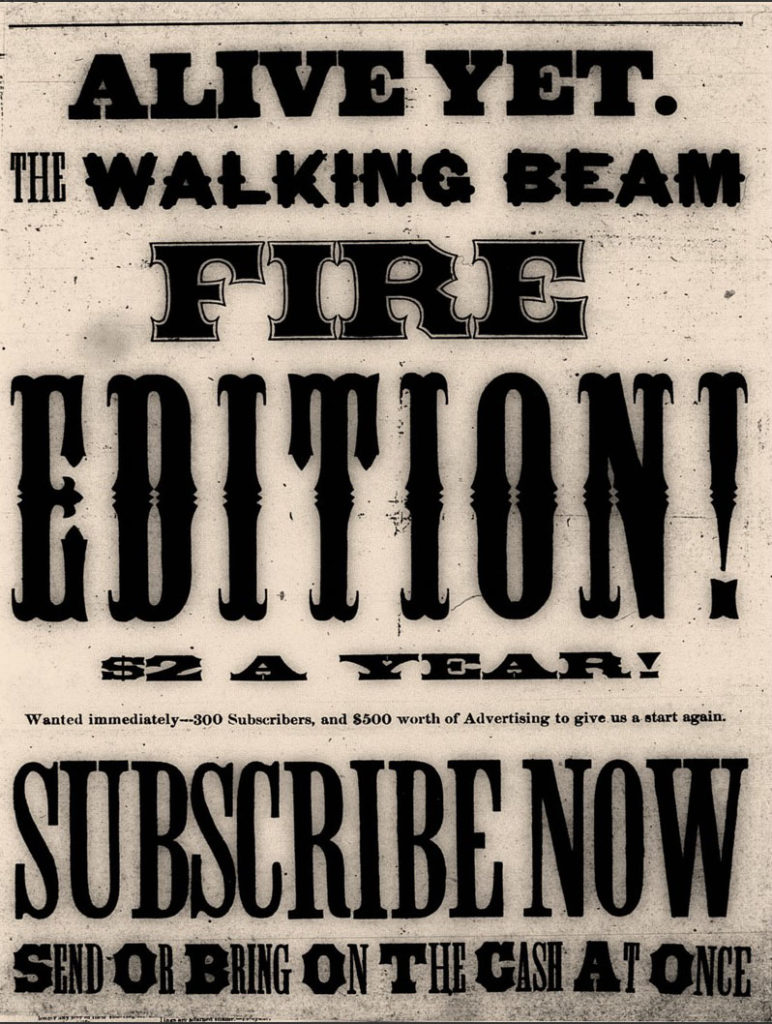Up in Smoke: The Fascinating Story of a West Virginia Newspaper, The Volcano Lubricator
Posted by Jane Metters LaBarbara.November 15th, 2016
Blog post by Stewart Plein, Rare Book Librarian.
In 1857, William Cooper Stiles, Jr. (1839-1896) arrived in Wood County with plans to search for suitable oil fields for his new enterprise. The sandy soil of Wood County seemed to Stiles to be perfectly suited for his plans. Stiles purchased 2,000 acres in Wood County in 1864, just as the Civil War was drawing to a close, and formed the Volcano Oil and Coal Company. Stiles commenced drilling on the undeveloped land and then began to lay out the town of Volcano. His future employees and their families would need residences and businesses with access to markets. At its peak, the population of Volcano reached just short of 4,000 residents.
The growth of the oil industry in Wood County and the surrounding area brought substantial increases in population and the establishment of new towns like Volcano. Newspapers such as the Volcano Lubricator, Sistersville Oil Review, West Virginia Walking Beam and West Union’s Derrick Herald served the oil fields and the boomtowns that arose overnight making West Virginia a leading center of America’s oil industry during the late nineteenth century.
The Oil Fields: Wooden derricks stretching across the horizon.
George Perry Sargent (1843-1899) was the editor and publisher of the Volcano Lubricator. The newspaper ran from 1871-1879. The newspaper’s name derived from the newly discovered use for oil as a lubricator, which was invented in Volcano.
Sargent, as publisher and editor of the Volcano Lubricator, reported on daily events in a boomtown that seemed to expand overnight, and he tended to shape this new population with editorials that were moralistic in tone. The following is an example of the type of content Sargent printed when he saw or heard of something that didn’t fit with his high moral standards of behavior:
“We learn that our Miss Jennie Casteel gave a public exhibition of herself on Sunday last, near the Twin Lick tressle (sic).
In her orgies, she was accompanied by two married men, whose names we will not mention this time owing to the fact, that we believe that there (sic) poor wives have enough disgrace to bear now.
But we never warn but once; next time we hear from you, young men, we shall get your names in type of no unmistakable character.”
Volcano Lubricator, September 16, 1873
Although Sargent holds back on the names of the men in this report, he has no compunction naming the woman involved.
Business information regarding the oil fields was regularly reported in the Volcano Lubricator and in turn, its reporting was repeated in such important reference resources as The Derrick Hand-Book of Petroleum Reports:
- “The Volcano Lubricator gives production of the West Virginia oil fields for the week ending July 20 at 1, 313 bbls., divided among six tracts and farms.”
- “The Volcano Lubricator reports the production of the West Virginia oil field for the week ending September 20 at 1, 413 bbls. The heavy oil, 28˚ to 35˚ gravity, at the wells, without packages, is quoted at $4.40 to $12. Light crude oil at Parkersburg, 11@121/2c.”
- “The Volcano Lubricator gives the production of the West Virginia lubricating oil district for the week ending November 9 at 1,888 bbls.”
- “The Volcano Lubricator reports the production of the West Virginia lubricating oil fields at 100 bbls. per day.”
- “The Volcano Lubricator says that 29 rigs are in course of construction on the Volcano Coal & Oil Company’s tract . . . Contracts have been let for the building of six other rigs.”
- “Volcano Lubricator believes that the oil business in that State is in its infancy and will yet bring the Commonwealth into commercial importance.”
In addition to business reporting, readers also found advertisements in the pages of the Volcano Lubricator. Here are a few examples of what subscribers could expect to see:
October 26, 1871 Vol. 1 Volcano Lubricator
Contents of the issue include:
Articles:
“Why Flirts Don’t Marry”
Columns:
All Sorts – “Grapes are so cheap in Iowa they sell for 3 cents a bushel!”
“A Detroit 11 year old girl chews tobacco!”
Ads:
Natural West Virginia Lubricating Oil
Oil Tanks and Mineral Wells
Oysters! Fresh Oysters!
On or after this date The Parshall House will be receiving Fresh Oysters!
Perhaps the first question that comes to mind concerning the arrival of fresh oysters, a real treat for the oil hands and their families, would be to ask from what body of water might the oysters have originated and how were they shipped to Wood County? Just how “fresh” were they upon arrival?
A gusher! The pumping apparatus to the left behind the derrick is referred to as a “walking beam,” for the movement it makes while pumping the oil.
Volcano had not one, but two newspapers in town. The other newspaper was called the Walking Beam, for the pumping mechanism used to bring oil to the surface. According to Wikipedia, “A pumpjack is the overground drive for a reciprocating piston pump in an oil well. It is used to mechanically lift liquid out of the well if not enough bottom hole pressure exists for the liquid to flow all the way to the surface. The arrangement is commonly used for onshore wells producing little oil. … The engineering term for this type of mechanism is a walking beam.”
Here’s a taste of what subscribers could expect from the pages of the Walking Beam:
Columns:
“Story of an Artic Expedition”
“How to Become a Comic Writer”
Although it might seem surprising to see an article on the art of the comic writer in the pages of an oil field newspaper, humorous stories were very popular at the time. Comic writers of the day included Samuel Clemens, better known as Mark Twain, and Bret Harte, a comic writer even more popular than Twain.
Unfortunately, tragedy was soon to strike the town of Volcano. Fire broke out in one of the businesses downtown and though attempts were made to contain it, the fire quickly spread, consuming nearly the entire town as well as many of the residents’ homes. In the end, the combination of highly flammable oil, homes, businesses, derricks, oil rigs and pumps constructed from wood, and nonexistent firefighting techniques allowed the fire to sweep through the town destroying everything it touched.
The Volcano Lubricator reported the tragedy with this headline:
“The Fire Fiend has done the Work”
August 4, 1879 4:00 a.m.
The newspaper included a partial list of the businesses destroyed in the fire, including both the offices of the Volcano Lubricator and the Walking Beam:
Graham & Smith’s Store, Farrow Residence, Walking Beam Printing office, Volcano Office, Odd Fellows Hall, Kennedy’s Restaurant, Nicholi Hotel, U.S. Post Office, Bell’s Stable, barrel house, three derricks, boiler works, nine tanks. 630 barrels of heavy oil worth $3,600 were also destroyed in the blaze.
The town of Volcano never recovered from the devastating fire. Both newspapers, the Volcano Lubricator and the Walking Beam, moved to Parkersburg in an attempt to revive their businesses. Van A. Zevely, the publisher of the Walking Beam, issued this ad seeking support in the August 3, 1879 fire edition.
This advertisement relates the dire straits both newspaper publishers were under after the fire. Zevely’s plea for 300 subscribers at two dollars a year and five hundred dollars’ worth of advertising would have been a stretch for a town that was completely consumed by fire and residents who were struggling to rebuild. Neither paper survived the transition in Parkersburg.
After the Walking Beam was “burned out,” Zevely moved to Cairo and continued to publish the Walking Beam until 1889, then to Pennsboro, changing the name to the Beacon Light. Zevely moved the paper again to Lincoln County and continued publishing until his health failed. In the end, both newspapers, the Volcano Lubricator and the Walking Beam, would become casualties of the fire.
Both newspapers are available for readers at the West Virginia and Regional History Center. Currently, they are available on microfilm, and in addition, a few of the original newspapers’ issues are also available in their original newspaper format.
The WVRHC will be digitizing both newspapers as part of the third grant awarded by the National Endowment for the Humanities/Library of Congress National Digital Newspaper Project. In the near future, both newspapers, as well as several others in the third grant cycle, will join the WVRHC’s digitized historic West Virginia newspapers from the first and second grant cycles on the Library of Congress Chronicling America website: http://chroniclingamerica.loc.gov/newspapers/west_virginia/
Come on in and read more about it!
Resources:
- Volcano Lubricator masthead and Walking Beam advertisement: WVRHC microfilm
- Photograph of Stiles: http://www.mackeysclockrepair.com/historyvolcano.html
- All other images: West Virginia & Regional History Center
- Walking Beam definition: Wikipedia: https://en.wikipedia.org/wiki/Pumpjack
- Van A. Zevely: West Virginia and Its People, Volume 1 by T.C. Miller: Google Books: https://books.google.com/books?id=_QcIAwAAQBAJ&pg=PA304&lpg=PA304&dq=Van+A.+Zevely+walking+beam&source=bl&ots=iEqqqCHs6A&sig=XwPmES7dbGhJeoUGZdqteyxn3wA&hl=en&sa=X&ved=0ahUKEwjE7bydwajQAhVo5YMKHSGzCPoQ6AEIHzAB#v=onepage&q=Van%20A.%20Zevely%20walking%20beam&f=false











January 14th, 2018 at 5:27 pm
I enjoyed reading this article very much. My paternal great-great grandfather was George Perry Sargent and my father, George Perry Parker, inherited quite a few of the weekly publications of the Volcano Lubricator. I recall reading about Miss Jennie Casteel at 15 years of age
and told my mother what I had just read. She told me that it was scathing regarding prostitution and adultery, I had to look both words up in the dictionary!